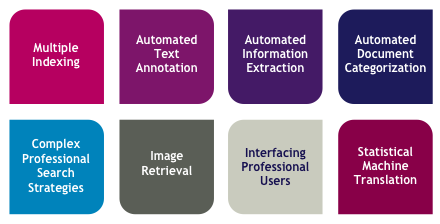IRF Key Research Areas
The IRF focuses on large scale information retrieval and continuously evaluates its industrial relevance:
Automated annotation and information extraction
Relevant information is extracted from unstructured text and made available in the form of a database that bests suits specific needs.
Automated document categorization
We are developing a novel categorization method for documents that combines supervised machine learning and ontological reasoning, facilitating further processing and future search challenges.
Machine translation
Statistical machine translation (SMT) engines generate translations on the basis of statistical models derived from the analysis of bilingual text corpora. Although far from replacing human translations, SMT offers means to locate and identify potential strategic information in foreign language documents.
Image Retrieval in technical documents
The technique being developed enables efficient image searches (even when using only part of an image) for a variety of technical drawings, such as flow charts, block diagrams, time charts and graph plots.
Information Visualization
The IRF investigates the use of graphical representations and mapping techniques to provide intuitive views and interfaces to large data, thereby facilitating interpretation and analysis.
Interfaces and Workflows
One of our projects aims at translating extensive information search tasks that rely partly on complex search algorithms in an easy-to-use graphical interface based on the workflow paradigm. One of the benefits is the reusability of complicated search patterns by less experienced professionals.
Professional search
Another one of our projects consists in developing an integrated, online translation platform, where several human experts can take advantage of existing web-content and machine translation tools to collaboratively select and translate patents.
Patent Information Retrieval
Since its foundation in 2007, the IRF has endeavoured to raise the interest of the IR community for the challenges related to patent search. The rapid increase in research papers mentioning the word “patent” underlines the success of this initiative. View chart
